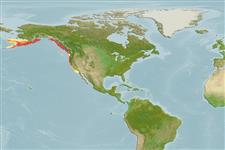Actinopterygii (ray-finned fishes) >
Scorpaeniformes (Scorpionfishes and flatheads) >
Cottidae (Sculpins)
Etymology: Hemilepidotus: Greek, hemi = half + Greek, lepis = scale + Greek, ous, otis = ear (Ref. 45335). More on author: Ayres.
Environment / Climate / Range
Ecology
Marine; demersal; depth range 0 - 780 m (Ref. 5515). Temperate, preferred ?; 59°N - 32°N
Eastern Pacific: Puffin Bay, southeastern Alaska to Santa Barbara Island, southern California, USA.
Size / Weight / Age
Maturity: Lm ? range ? - ? cm
Max length : 29.0 cm TL male/unsexed; (Ref. 2850)
Dorsal
spines
(total): 11;
Dorsal
soft rays
(total): 18-20;
Anal
spines: 0;
Anal
soft rays: 14 - 16;
Vertebrae: 35. Dorsal deeply notched between third and fourth spine, and between spinous and rayed portions; caudal rounded (Ref. 6885). Color brown, often tinged with red on dorsal surface, mottled and barred with 4 dark saddles over dorsal surface (Ref. 6885).
Occurs in intertidal areas and down to at least 130 or 780 m depth (Ref. 5515). Usually found in subtidal areas of exposed coasts (Ref. 2850). Feeds on crustaceans (Ref. 6885).
Life cycle and mating behavior
Maturity | Reproduction | Spawning | Eggs | Fecundity | Larvae
Eschmeyer, W.N., E.S. Herald and H. Hammann, 1983. A field guide to Pacific coast fishes of North America. Boston (MA, USA): Houghton Mifflin Company. xii+336 p. (Ref. 2850)
IUCN Red List Status (Ref. 115185)
CITES (Ref. 94142)
Not Evaluated
Threat to humans
Harmless
Human uses
More information
ReferencesAquacultureAquaculture profileStrainsGeneticsAllele frequenciesHeritabilityDiseasesProcessingMass conversion
Tools
Special reports
Download XML
Internet sources
